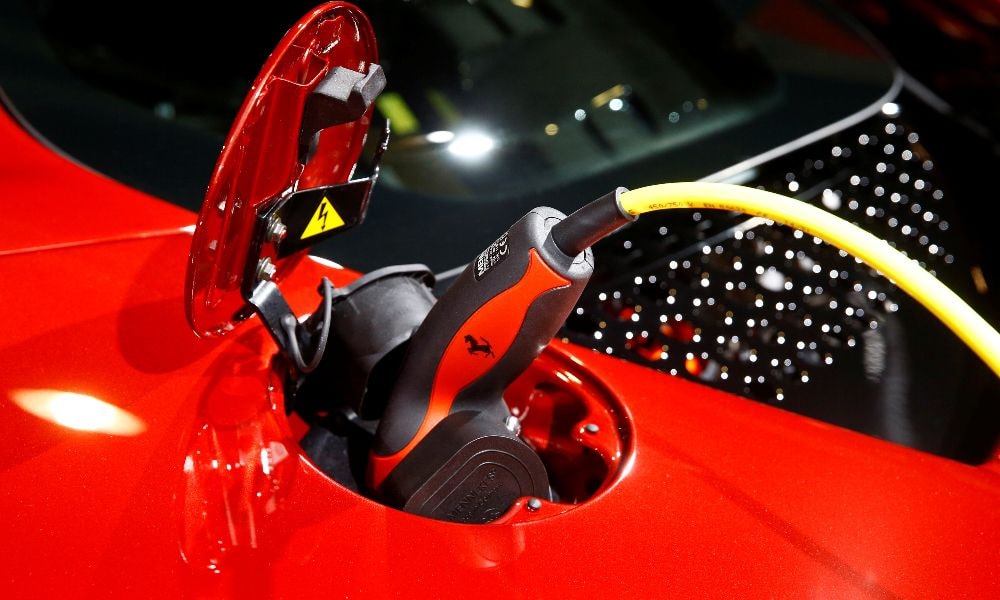Non-Hydro Renewable Energy Capacity Addition Grew 61 Per Cent In Q1 FY2023: Report

- New capacity addition of non-hydro renewable energy increased to 4.2 GW.
- Sales of electric vehicles jumped by 636 per cent.
- The share of EVs in total new vehicles sold increased to 4.35 per cent.
According to the latest edition of the CEEW Centre for Energy Finance (CEEW-CEF), new capacity addition of non-hydro renewable energy increased to 4.2 GW during the first quarter of FY2023 compared to just 2.6 GW installed in the same period last fiscal. This is about a 61 per cent jump in new renewable energy (RE) capacity addition on a year-on-year basis. In addition to more investment in the sector, the sharp increase in capacity generation could also be attributed to the low base in the corresponding quarter when capacity installations took a hit due to the Covid-19- lockdowns. The CEEW-CEF Market Handbook also highlighted that despite various fire incidents, sales of electric vehicles jumped by 636 per cent to a little over 2 lakh units in Q1 FY2023 compared to the corresponding period. The share of EVs in total new vehicles sold during the quarter increased to 4.35 per cent compared to less than one per cent in the same quarter previous fiscal.
Gagan Sidhu, Director, CEEW Centre for Energy Finance, said, " Continued low share of wind capacity addition is a matter of concern as India's power sector transition cannot be based on solar alone. However, there are also some encouraging signs. A significant 1,200MW of wind capacity was auctioned in Q1FY23. This is in addition to another 1,200MW of wind-solar hybrid that was separately auctioned in the quarter. Further, wind energy has also received a regulatory push in recent weeks. First is the move to do away with reverse auctions for wind tariff discovery. Second is the introduction of a dedicated Renewable Purchase Obligation (RPO) for wind capacity commissioned post-March 2022. The former is a long-standing demand of the wind industry, whilst the latter is a regulatory demand creator."
Overall, RE accounted for 98 per cent of the total 4.3GW electricity generation capacity added during the quarter. Within RE, solar energy dominated, representing 89 per cent of the total 4.2GW of RE added. This was partly on the back of strong demand for grid-scale and rooftop solar additions. However, wind energy capacity additions continued to lag at just 430MW. In terms of capacity auctioned, a significant 48 per cent of the 3.15GW of RE auctioned in the quarter comprised innovative procurement formats such as hybrid RE and floating solar. The newly published handbook further highlighted that India's peak power demand (met) reached a new high of 211.9 GW in June 2022 and crossed the 200 GW mark in each month of the first quarter as a result of the prolonged heat waves and delayed arrival of monsoons. In generation terms, the total power generated increased by 16 per cent in Q1 FY2023 to reach 411 billion kilowatt-hours (kWh) compared to 354 billion kWh in Q1 FY22.
Trending News
 3 mins readWill The Kawasaki W230 Be Launched In India?
3 mins readWill The Kawasaki W230 Be Launched In India?
Latest News
 Jaiveer Mehra | Dec 26, 2025India-Spec New Renault Duster Teased Ahead Of Jan 26 DebutA new teaser video provides brief glimpses of the upcoming all-new SUV which seems to get some notable styling differences over its global sibling.1 min read
Jaiveer Mehra | Dec 26, 2025India-Spec New Renault Duster Teased Ahead Of Jan 26 DebutA new teaser video provides brief glimpses of the upcoming all-new SUV which seems to get some notable styling differences over its global sibling.1 min read Jaiveer Mehra | Dec 26, 2025New Mahindra XUV 7XO Teaser Confirms 540 Degree CamerasLatest teaser video confirms the SUV will get the new 540 degree camera set-up from the XEV series as well as a few other features.1 min read
Jaiveer Mehra | Dec 26, 2025New Mahindra XUV 7XO Teaser Confirms 540 Degree CamerasLatest teaser video confirms the SUV will get the new 540 degree camera set-up from the XEV series as well as a few other features.1 min read car&bike Team | Dec 24, 2025Updated Bajaj Pulsar 150 Launched At Rs 1.09 Lakh: Gets LED Lighting, New ColoursThe Pulsar 150 is offered in three variants with prices topping out at Rs 1.15 lakh (ex-showroom).2 mins read
car&bike Team | Dec 24, 2025Updated Bajaj Pulsar 150 Launched At Rs 1.09 Lakh: Gets LED Lighting, New ColoursThe Pulsar 150 is offered in three variants with prices topping out at Rs 1.15 lakh (ex-showroom).2 mins read Janak Sorap | Dec 24, 20252026 Kawasaki Ninja 650 Launched at Rs 7.91 LakhWith E20 compliance, the 2026 Ninja 650 receive a new colour update and a premium price tag.1 min read
Janak Sorap | Dec 24, 20252026 Kawasaki Ninja 650 Launched at Rs 7.91 LakhWith E20 compliance, the 2026 Ninja 650 receive a new colour update and a premium price tag.1 min read Jafar Rizvi | Dec 24, 2025Listed: Car Manufacturers That Will Hike Prices From January 2026Based on the announcements made so far, the price increase across car models is expected to range between 2 and 3 per cent.3 mins read
Jafar Rizvi | Dec 24, 2025Listed: Car Manufacturers That Will Hike Prices From January 2026Based on the announcements made so far, the price increase across car models is expected to range between 2 and 3 per cent.3 mins read car&bike Team | Dec 24, 2025KTM RC 390 Discontinued Globally, Remains On Sale In IndiaThe KTM RC 390 will continue to be offered on sale in India, where it is manufactured and there’s still strong demand for the model.2 mins read
car&bike Team | Dec 24, 2025KTM RC 390 Discontinued Globally, Remains On Sale In IndiaThe KTM RC 390 will continue to be offered on sale in India, where it is manufactured and there’s still strong demand for the model.2 mins read
 Jafar Rizvi | Dec 24, 2025MG Windsor EV 38 kWh Long-Term Report: IntroductionThe Windsor EV has joined our garage, and before it settles into daily duty, I took it out to get a sense of what living with an electric car is like.4 mins read
Jafar Rizvi | Dec 24, 2025MG Windsor EV 38 kWh Long-Term Report: IntroductionThe Windsor EV has joined our garage, and before it settles into daily duty, I took it out to get a sense of what living with an electric car is like.4 mins read Seshan Vijayraghvan | Dec 23, 20252026 Kia Seltos Review: Formula Is Spot On, But Is The Timing Right?The 2nd-gen Kia Seltos has arrived, but it has the challenge of facing strong rivals like the Victoris and Sierra. The question is simple - Does it still have what it takes?9 mins read
Seshan Vijayraghvan | Dec 23, 20252026 Kia Seltos Review: Formula Is Spot On, But Is The Timing Right?The 2nd-gen Kia Seltos has arrived, but it has the challenge of facing strong rivals like the Victoris and Sierra. The question is simple - Does it still have what it takes?9 mins read car&bike Team | Dec 26, 2025Tata Punch EV Long-Term Second Report: Highway Performance, Pros & ConsAfter a week of living with the Tata Punch EV Long Range—including a proper Mumbai-Nashik highway test—we've learned what this little electric SUV is really made of.1 min read
car&bike Team | Dec 26, 2025Tata Punch EV Long-Term Second Report: Highway Performance, Pros & ConsAfter a week of living with the Tata Punch EV Long Range—including a proper Mumbai-Nashik highway test—we've learned what this little electric SUV is really made of.1 min read Seshan Vijayraghvan | Dec 22, 20252026 Tata Harrier & Safari 1.5 Hyperion Review: By The Power Of Petrol!The new Tata Harrier and Safari petrol packs a new 1.5-litre TGDI Hyperion engine, but is it an ideal alternative to the diesel version?7 mins read
Seshan Vijayraghvan | Dec 22, 20252026 Tata Harrier & Safari 1.5 Hyperion Review: By The Power Of Petrol!The new Tata Harrier and Safari petrol packs a new 1.5-litre TGDI Hyperion engine, but is it an ideal alternative to the diesel version?7 mins read Bilal Firfiray | Dec 19, 2025Maruti Suzuki e-Vitara Review: Worth The Wait?After a long wait, the first-ever electric Maruti Suzuki is here. It’s the e-Vitara, and it comes with a few promises. But arriving this late, is it worth the wait? Or is it a case of too little, too late?9 mins read
Bilal Firfiray | Dec 19, 2025Maruti Suzuki e-Vitara Review: Worth The Wait?After a long wait, the first-ever electric Maruti Suzuki is here. It’s the e-Vitara, and it comes with a few promises. But arriving this late, is it worth the wait? Or is it a case of too little, too late?9 mins read































































































































